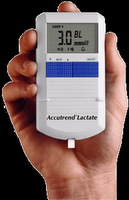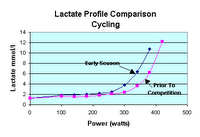 I have produced what I think is a posting aimed at the general audience. If anyone wishes more specific information, please note it in the comments and I will follow up.
I have produced what I think is a posting aimed at the general audience. If anyone wishes more specific information, please note it in the comments and I will follow up.Many have heard of lactate testing but few have had the chance to see it in action. I have had the opportunity as a graduate student to test rowers, swimmers, cyclists and runners in both Canada and the USA. Until recently these tests could only be completed in a lab with very expensive equipment.
 Now there are a few options for portable analyzers that work just like blood glucose monitors used by diabetics. These analyzers cost about $300 and each test costs about $2. I worked on one study validating their use by comparing them to the YSI 1500 analyzer considered by many to be a gold standard. I have also worked with the YSI Sport - a more portable model used for field testing.
Now there are a few options for portable analyzers that work just like blood glucose monitors used by diabetics. These analyzers cost about $300 and each test costs about $2. I worked on one study validating their use by comparing them to the YSI 1500 analyzer considered by many to be a gold standard. I have also worked with the YSI Sport - a more portable model used for field testing.
Essentially, we know that as the intensity of exercise increases the muscles produce lactic acid (lactate). Generally, at lower intensities that can be sustained aerobically - steady state intensities - the concentration of lactate in the blood increases in a liner way compared to wattage. At the "lactate threshold" there is a sharp increase in the production of lacate as the body has to resort to anaerobic metabolism to sustain higher wattage workloads.
Tests are conducted as a series 4-5 of steady workloads that the athlete maintains for a given period of time - typically five minutes. Immediately after each workload a small fingerprick (or earlobe) sample is taken to get a blood lactate concentration. This concentration is plotted on a graph vs. wattage. Sometimes a clear deflection point can be found. More often than not it is unclear and requires a trained eye to find. In any case this would be the individual's lactate threshold. This is the workload that an athlete can sustain for a long period of time - 30 minutes or more.
As finding the deflection point is tricky, many choose to use a lactate concentration of 4 mmol/L as the lactate threshold, be definition. This can be found from the graph by extrapolation, and again it will tell the athlete at what wattage they hit their anaerobic threshold. The 4 mmol/L is the point used in testing by Lance Armstrong. He apparently does not use this as a rigid point for dictating training, but more as a indication of his current fitness. He has done the test so many times that it gives him a gauge of how things are going and if he needs to adjust his training. For more information on how Lance uses testing I strongly recommend these two books, mentioned yesterday:
One of the more important uses of the test can be to monitor not just training, but overtraining. What do I mean by this? Under normal circumstances you would expect an athlete's curve to shift down and to the right as they get fitter. (see image). This means that they can sustain a higher wattage for a given blood lactate concentration. That's a nice thing to see as you test, but perhaps more interesting is what if you don't see this shift? First, one caveat: the test is subject to some variability if not done at the same time of day, under the same circumstances including diet and rest. Assuming all else is equal a shift of the curve in the wrong direction should send off warning bells. It may mean illness, or it may mean overtraining and the need for immediate rest. What is more interesting is that quite often the same thing cannot be seen just by looking at heart rates.Inside Lance Armstrong's War, by Daniel Coyle
Lance Armstrong Performance Program, by Lance Armstrong, Chris Carmichael and Peter Joffre Nye
Of course the test is also used to give data that are (believed by some to be) more accurate than heart rates for prescribing training. Many countries have produced training zone information for rowing, and they sometimes contain lactate concentrations that correspond to specific workout types. More on this in the next post when I look at the information from the test.
How is the test done with rowers?
Start with one ergometer, a heart rate monitor and the lactate testing kit.
I have conducted four stage tests, and thrown in an extra stage if needed because an athlete has not passed threshold. After a full warm-up, the athlete rows a five minute steady wattage stage before a sample is taken. A three minute rest (including sampling time) precedes the next stage. A heart rate is also taken near the end of each stage so that the information given by the lactate data can be correlated with heart rates for use while training, since it is so simple to carry a heart rate monitor in the boat.
It is the athlete's responsibility to maintain the prescribed wattage. We did not prescribe stroke rate, preferring to have the athletes choose a comfortable rate that would apply more directly to their training later.
We worked with set workloads for National Team athletes of:
Women: 175 W, 200W, 235W, 270W
Men: 295W, 330W, 365W, 400W
For one athlete in particular these workloads had to be increased as he was at a level well above all the others on the team, so you need to be flexible based on the individuals involved, if they have not clearly passed threshold after the fourth test we would add in one extra stage 30-40W higher.
The athletes are aiming for this wattage, but you record the actual average watts reported by the erg monitor after each stage.
The Accusport link below indicates an American test done with individual workloads that are in a similar range but based on a first test that establishes a maximal lactate concentration.
When lactate concentration is plotted vs. Wattage the curve is seen. We used the 4 mmol/L point as the threshold used for training prescriptions.
More information is available at these links:
Web Information
Stephen Seiler's Site, which includes rowing-specific information
Portable Lactate Analyzer
UK Peak Performance Online Article on Accusport
Accusport Analyzer who also have an article on basic concepts of testing this is an excellent article and it includes a section specifically on rowing.
The Lactate Pro Analyzer - used by Lance Armstrong and many national teams
Books
see Amazon.com on Lactate Testing "Lactate Threshold Training" is especially interesting and it actually refers a bit to the work of Conconi, cited yesterday.

